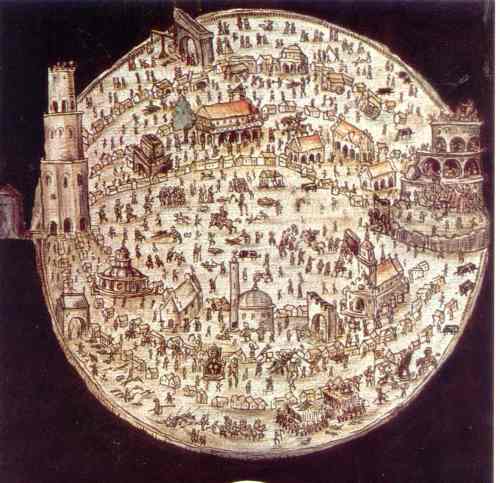Eco: Comenius
by Estéban Trujillo de Gutiérrez

Jan Amos Comenius (1592-1670), Labyrinth of the World and Paradise of the Heart, the initial version was completed in 1623, while the first edition was published in 1631. The entire work is posted in an electronic edition. This work is in the public domain in its country of origin and other countries and areas where the copyright term is the author’s life plus 100 years or less.
“The British quest was also influenced by the presence of Comenius (Jan Amos Komensky). In fact Comenius was a member of the Bohemian Brotherhood, a mystic branch of Hussite reformers, and he played a role–albeit a polemical one–in the Rosicrucian story (cf. his Labyrinth of the World, 1623, in Czech).
Thus he was inspired by religious ideals which were alien to the scientific purposes of the English milieu. On this complex cultural geography see Yates (1972, 1979): one is really facing a web of different projects, at once similar and antithetical, in which the search for a perfect language was but a single aspect (see Rossi 1960; Bonerba 1992; Pellerey 1992a: 41-9).
Comenius‘ aspirations must be seen in the framework of the tradition of pansophia, yet his pansophic aims were influenced by educational preoccupations. In his Didactica magna of 1657, he proposed a scheme for reforming teaching methods; for, as he observed, a reform in the education of the young formed the basis upon which any subsequent political, social and religious reform must be built.
It was essential that the teacher furnish the learners with a set of images that would stamp themselves indelibly on their imaginations. This meant placing what is visible before the eyes, what is audible before the ears, what is olfactory before the nose, gustatory before the tongue, and tactical before the touch.
In an earlier manual for the teaching of Latin, Janua linguarum, written in 1631, Comenius was first of all concerned that the learner should have an immediate visual apprehension of what was being spoken of.
Equally he was concerned that the images and notions that the learner was studying in the Latin lexicon be arranged in a certain logical order.
Thus lessons progressed from the creation of the world to the elements, to the mineral, vegetable and animal kingdoms, etc.
By the time of the Didactica magna Comenius had begun to rearrange his notions according to the suggestions of Bacon. In 1658 there appeared the Orbis sensualium pictus quadrilinguis, which represented his attempt to present a figured nomenclature which would include the fundamental things of the world together with human actions.
So important were the images that Comenius delayed publication until he was able to obtain satisfactory engravings that were not mere ornaments, but bore an iconic relation with the things represented, for which the verbal names appeared as nothing but titles, explanations and complements.
This manual was prefaced by an alphabet in which every letter was associated with the image of a particular animal whose voice recalled the sound of the letter–so that the result resembles Harsdörffer’s onomatopoetic fantasies concerning the sounds of German.
Therefore the image of a crow is commented by “Die Krähe krächzet, cornix cornicatur, la cornacchia gracchia, la corneille gazoüille,” or, for a snake, “Die Schlange zischtet, Serpens sibilat, il Serpe fsschia [sic], le Serpent siffle.”
Comenius was a severe critic of the defects of natural languages. In his Pansophiae Christianae liber III (1639-40), he advocated a reform that would eliminate the rhetorical and figurative use of words, which he regarded as a source of ambiguity.
The meaning of words should be fixed, he demanded, with one name for each thing, thus restoring words to their original meanings.
In 1668, in the Via lucis, Comenius offered prescriptions for the creation of an artificial universal language. By now, pansophy was more than an educational method; it was a utopian vision in which a world council was supposed to create the perfect state along with its perfect philosophical language, the Panglossia.
It is interesting to consider that Comenius had in fact written this work before 1641, when, after wandering through the whole of Europe in the course of the Thirty Years War, he had taken refuge in London.
Via lucis certainly circulated, in manuscript form, in the English milieu at that time (see, for example, Cram 1989).
Although Comenius was never to construct his new language in extenso, he had broached the idea of a universal tongue which had to overcome the political and structural limitations of Latin.
The lexicon of the new language would reflect the composition of reality and in it every word should have a definite and univocal meaning, every content should be represented by one and only one expression, and the contents were not supposed to be products of fancy, but should represent only every really existing thing, no more and no less (see Pellerey 1992a: 48).
Thus, on one side we have a utopian thinker, inspired by Rosicrucian ideals, whose goal was to discover a pansophy which aimed at picturing the unmoving and harmonical connection of every element of the creation, so as to lead the human mind to an unceasing quest for God; on the other side, rejecting the possibility of rediscovering the original perfect language, and looking, for educational purposes, for an easy artificial method, Comenius became the forerunner of that search for an a priori philosophical language that would later be implemented by English utopian thinkers whose inspiration was more scientific than theological or mystical.”
Umberto Eco, The Search for the Perfect Language, translated by James Fentress, Blackwell. Oxford, 1995, pp. 214-6.
